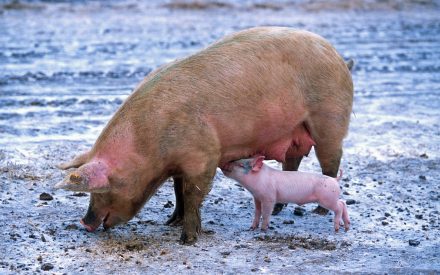Paige Isensee, Veterinary Medicine at the University of Missouri student, presented this topic at the 2020 Badger Swine Symposium.
https://youtu.be/jRncct2E3Tc
Show Transcript
Paige Isensee 00:01
Hello, everybody, and thank you for joining today. My name is Paige Isensee and today I’m going to be talking about creep feed and varying diet complexities and how that affects growing piglets. First, a little bit about myself, just so you know who is talking to you. I graduated from the University of Wisconsin-River Falls in May of 2020. And I am now studying Veterinary Medicine at the University of Missouri. I began this fall and plan to graduate in May of 2024.
Paige Isensee 00:46
First, let’s go over a little bit of background as to what is creep feed and when should we offer it, and the big question of why should we offer it? So, creep feed is a highly digestible and nutrient-rich feed. And we can offer it to piglets during the suckling stage to add an adaptation period and supplemental nutrients to the piglets.
Paige Isensee 01:14
So the goal is to add nutrients, and hopefully help the development of the piglets’ digestive tract, in addition to introducing the piglets to a solid feed, instead of going from an abrupt change of that liquid diet of sow’s milk to a solid feed in the nursery phase.
Paige Isensee 01:39
So we had to look at why, why should we do this research and what should we look at exactly? While we do know that piglets digestive system is not fully developed at the time of weaning, so because of that, there is a high potential to have post-weaning growth lag, or have the piglets lose weight, in that few days to a week after weaning before they start to gain weight again.
Paige Isensee 02:12
Offering creep feed during the lactation phase for the sow may be beneficial to enhance feed intake for the piglets after weaning, resulting in an increased post-weaning growth rate.
Paige Isensee 02:28
There is currently little information about how quickly the piglets become eaters and the nursery of the nursery diet after weaning. So we wanted to look at that a little bit more and find out: does creep feed affect how quickly a piglet will become an eater after weaning?
Paige Isensee 02:52
So the objective of this trial was to evaluate the effect that creep feed and its nutrient levels has on piglet growth, during the transition from the suckling stage to the weaning stage, in order, in order to demonstrate a subsequent response of piglets to nursery feed post-weaning.
Paige Isensee 03:19
So this consisted of two different experiments. First, we’ll talk about experiment one, and then I’ll introduce you to experiment two. For experiment one, we had a total of eight litters, and we alotted them into two treatments at day 20. There were two treatments: one consisted of a control group that was not offered any creep feed, and the other was our creep feed treatment, where we did offer piglets creep feed eight days prior to weaning. The goal was to introduce them to that solid feed and hope for an increased nutrient level intake and an adaptation period prior to weaning. On day 28 of age, piglets, were categorized as eaters and non-eaters, and then divided into three different treatments, and weaned.
Paige Isensee 04:21
So the three treatments consisted of our control group, which was the piglets that did not receive any creep feed, eaters and non-eaters and how we categorized our eaters and non-eaters was based on fecal color. So the eaters ingested enough creep feed that it was evident in their feces that they had ingested creep feed and it has made it through the digestive tract, where non-eaters did not ingest or did not ingest enough of the creep feed in order to see it in the feces.
Paige Isensee 05:06
Looking at that fecal color, the one on the bottom, you can clearly see is a much darker green than the natural color of the fecal sample on the top. So, the bottom would be considered an eater and the top would be considered a non-eater because we used a chromic oxide dye indicator that was mixed in with the feed. And this indicator was harmless to the piglets and indigestible. So it would come through in the feces if the piglet ingested enough creep feed and it would not be evident in those that did not ingest creep feed.
Paige Isensee 05:51
Looking at our setup for experiment two, we had a total of seven litters that were allotted into two different treatments. And this happened on day 12 of age. And they were offered creep feed until weaning. So the two different treatments consisted of a high nutrients level treatment and a low nutrient level treatment. So our high nutrient level treatment consisted of creep feed with fish meal, blood meal, and whey in it. And our low nutrient treatment lacked those ingredients. And those ingredients were replaced with just corn.
Paige Isensee 06:37
On day 25 of age, all piglets were weaned. And at this time, they were categorized as eaters and non-eaters, and allotted into two different treatments. So we had our high nutrient treatments, and our low nutrient treatment and both were separated into eaters. And again, we used fecal color to categorize these piglets as eaters and non-eaters, just like we did in experiment one. And I would just like to point out that a common nursery feed was used for the nursery period in both experiments.
Paige Isensee 07:23
Going back to experiment one, looking at our creep feed period, during experiment one, we did not see any difference in initial body weight or weaning weight for the piglets on trial. So overall, there was no difference in the average daily gain of the piglets during the creep feed period. But looking at the nursery period during experiment one, we also not see a difference in the groups when we looked at how long it took piglets to become eaters of the nursery feed, post weaning. Looking at experiment two we again, do not see a difference and the initial body weight or weaning weight, leading to no difference in average daily gain of the piglets during that creep feed period. I would like to point out that during the nursery period, our high nutrient group, did have a tendency to have an increased average daily gain and in our low nutrient group during that second week post-weaning. This also led to a higher gain to feed ratio for that high nutrient group during that second week post-weaning as well.
Paige Isensee 08:48
So overall, there were no differences in the growth performance of the piglets during the suckling period or the nursery period for both experiments. There was no difference in the proportion of nursery feed eaters, between groups during the first three days post weaning in both experiments, and the creep feed intake and the percentage of eaters per litter were not different between treatments during an experiment two. And it is important to note that our high nutrient creep feed eaters tended to have a greater average daily gain and gain to feed ratio, then the low nutrient eaters during that second week post weaning in the second trial.
Paige Isensee 09:40
So in conclusion, creep feed did not affect piglet growth rate in the overall suckling and nursery phases. Nutrient level of creep feed could have an effect on piglet growth during the early nursery phase though as seen in experiment two. So we would have to replicate this study and increase our numbers to see if we can see this effect again. And with that, I would like to thank you for your attention today. And please feel free to email me with any questions and have a great day.

 Welcome to the 2021 Badger Swine Symposium
Welcome to the 2021 Badger Swine Symposium Nutritional strategies to stop pig growth during crisis management - 2021 Badger Swine Symposium
Nutritional strategies to stop pig growth during crisis management - 2021 Badger Swine Symposium Methods to assess dietary phosphorus adequacy for sows - 2021 Badger Swine Symposium
Methods to assess dietary phosphorus adequacy for sows - 2021 Badger Swine Symposium New techniques to monitor regression of osteochondrosis lesions - 2021 Badger Swine Symposium
New techniques to monitor regression of osteochondrosis lesions - 2021 Badger Swine Symposium


